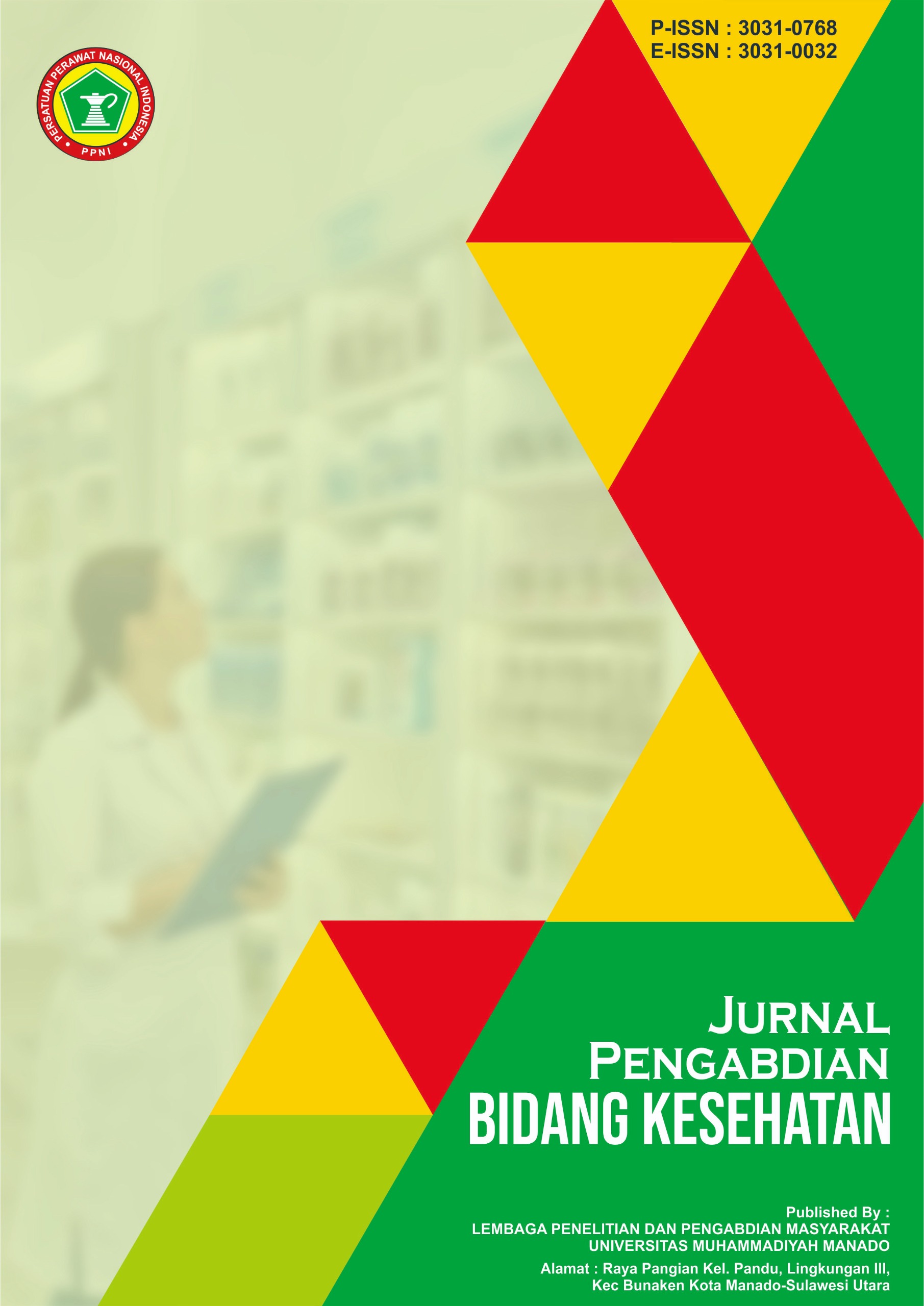Upaya Pengendalian Hiperurisemia melalui Skrining dan Edukasi pada Populasi Dewasa di Gereja Asisi Jakarta
DOI:
https://doi.org/10.57214/jpbidkes.v3i2.189Keywords:
Early Detection, Hyperuricemia, Screening, Uric AcidAbstract
Hyperuricemia is a medical condition characterized by an increase in uric acid levels in the blood above normal limits, which can trigger various metabolic complications such as gouty arthritis, urate nephropathy, and cardiovascular disease. In the early stages, hyperuricemia is often asymptomatic, therefore routine investigation of uric acid level are an important step in early detection. The Community Service Program (PKM) implemented at the Asisi Church, Tebet District, aims to increase public awareness of the importance of early detection of hyperuricemia through blood uric acid level screening activities. This activity uses the Plan-Do-Check-Act (PDCA) approach, which includes capillary blood tests with Point-of-Care Testing (POCT) tools and education on risk factors, symptoms, and prevention of hyperuricemia. Of the 68 participants, all participants showed uric acid levels within the normal range. These results emphasize the importance of education and routine screening efforts to maintain uric acid levels within normal limits, prevent complications in the future, and build public awareness of the importance of a healthy lifestyle to maintain quality of life sustainably.
References
Du, L., Zong, Y., Li, H., Wang, Q., Xie, L., Yang, B., Pang, Y., Zhang, C., Zhong, Z., & Gao, J. (2024). Hyperuricemia and its related diseases: Mechanisms and advances in therapy. Signal Transduction and Targeted Therapy, 9(1), 212. https://doi.org/10.1038/s41392-024-01916-y
George, C., Leslie, S. W., & Minter, D. A. (2023). Hyperuricemia. In Urology at a glance (pp. 107–109). https://doi.org/10.1007/978-3-642-54859-8_23
Lin, Z., Lieske, J., Li, Y., & Jayachandran, M. (2019). High water intake in preventing the risk of uric acid nephrolithiasis: A systematic review and meta-analysis. Journal of Clinical Nephrology, 3(2), 126–142. https://doi.org/10.29328/journal.jcn.1001038
Ryu, K. A., Kang, H. H., Kim, S. Y., Yoo, M. K., Kim, J. S., Lee, C. H., & Wie, G. A. (2014). Comparison of nutrient intake and diet quality between hyperuricemia subjects and controls in Korea. Clinical Nutrition Research, 3(1), 56–63. https://doi.org/10.7762/cnr.2014.3.1.56
Santoso, A. H., Gunawan, S., Lo, G. C., Satya, M., Jaya, P., Valentino, &, & Lumintang, G. (2024). Pencegahan hiperuresemia dan obesitas melalui skrining kadar asam urat dan status gizi pada dewasa usia produktif di Jakarta Barat. Jurnal Serina Abdimas, 2(2), 536–544. https://journal.untar.ac.id/index.php/JSA/article/view/29277
Sim, A. S., & Goh, D. (2024). Deteksi dini dan penapisan kadar asam urat usia produktif di SMA Kalam Kudus II, Jakarta. JURAI: Jurnal Abdimas Indonesia, 2(2). [Link tidak tersedia]
Skoczyńska, M., Chowaniec, M., Szymczak, A., Langner-Hetmańczuk, A., Maciążek-Chyra, B., & Wiland, P. (2020). Pathophysiology of hyperuricemia and its clinical significance – A narrative review. Reumatologia, 58(5), 312–323. https://doi.org/10.5114/reum.2020.100140
Song, P., Wang, H., Xia, W., Chang, X., Wang, M., & An, L. (2018). Prevalence and correlates of hyperuricemia in the middle-aged and older adults in China. Scientific Reports, 8(1), 4314. https://doi.org/10.1038/s41598-018-22570-9
Tang, O., Miller, E. R., Gelber, A. C., Choi, H. K., Appel, L. J., & Juraschek, S. P. (2017). DASH diet and change in serum uric acid over time. Clinical Rheumatology, 36(6), 1413–1417. https://doi.org/10.1007/s10067-017-3613-x
Usman, S. Y., Darmawan, G., Hamijoyo, L., & Wachjudi, R. G. (2019). Hyperuricemia prevalence and its metabolic syndrome profiles. Indonesian Journal of Rheumatology, 11(2). https://doi.org/10.37275/ijr.v11i2.118
Wełniak, A., Białczyk, A., Wójcik, A., Zduńczyk, N., Górka, A., Jaśniak, A., Lazarek, M., Prudzic, P., Załęcki, P., & Kędziora-Kornatowska, K. (2022). Hyperuricemia as an interdisciplinary problem. Issues of Rehabilitation, Orthopaedics, Neurophysiology and Sport Promotion – IRONS, 41, 15–25. https://doi.org/10.19271/IRONS-000176-2022-41
Wen, S., Arakawa, H., & Tamai, I. (2024). Uric acid in health and disease: From physiological functions to pathogenic mechanisms. Pharmacology & Therapeutics, 256, 108615. https://doi.org/10.1016/j.pharmthera.2024.108615
Yokose, C., McCormick, N., & Choi, H. K. (2021). The role of diet in hyperuricemia and gout. Current Opinion in Rheumatology, 33(2), 135–144. https://doi.org/10.1097/BOR.0000000000000779
Zhang, Y., Chen, S., Yuan, M., Xu, Y., & Xu, H. (2022). Gout and diet: A comprehensive review of mechanisms and management. Nutrients, 14(17). https://doi.org/10.3390/nu14173525
Downloads
Published
How to Cite
Issue
Section
License
Copyright (c) 2025 Jurnal Pengabdian Bidang Kesehatan

This work is licensed under a Creative Commons Attribution-ShareAlike 4.0 International License.







